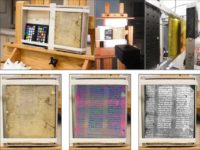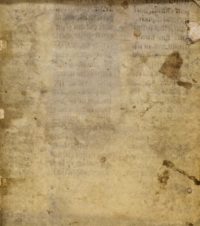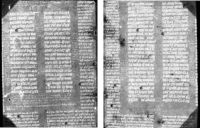 In the Middle Ages, old manuscripts were recycled for their valuable vellum and parchment pages. The writing was washed or scrubbed off and the leaves filling with new content. Because so many ancient works have been lost, scholars have for centuries attempted to recover the original texts from these medieval palimpsests, often using caustic materials that damaged the pages in the long term. Nowadays researchers have much better options thanks largely to a panoply of imaging technologies that have been a godsend to the study of palimpsests, revealing erased and overwritten text that cannot be seen with the naked eye. Synchrotron imaging is better than Superman because it can see through lead boxes.
In the Middle Ages, old manuscripts were recycled for their valuable vellum and parchment pages. The writing was washed or scrubbed off and the leaves filling with new content. Because so many ancient works have been lost, scholars have for centuries attempted to recover the original texts from these medieval palimpsests, often using caustic materials that damaged the pages in the long term. Nowadays researchers have much better options thanks largely to a panoply of imaging technologies that have been a godsend to the study of palimpsests, revealing erased and overwritten text that cannot be seen with the naked eye. Synchrotron imaging is better than Superman because it can see through lead boxes.
Some of the recycled parchments pose greater challenges than others. With the introduction of the printing press to Europe in the 15th century, the demand for bookmaking materials soared. Not only were medieval manuscripts cannibalized for their pages, but the bindings were reused to bind newly printed books. This was a common practice well into the 18th century, so there are a lot of old printed books out there with fragments of medieval and ancient texts hidden in the binding. Scholars knew there might be literary treasures in there, but were stumped by the difficulty of accessing and reading binding materials.
Now researchers at Northwestern University have made a breakthrough. It was a book from the university library’s collection that inspired the new approach. It’s an edition of the Works and Days by the Greek poet Hesiod that was printed in Venice in 1537. Northwestern acquired it in 1870 and out of the 30 known surviving copies of the edition, this is the only one that still has its original slotted parchment binding, a widely used technique in Venice from 1490 to 1670 in which slots were cut into the binding parchment to match the shape of the book spine.
Slotted parchment bindings often used recycled parchments. The ink was usually removed for aesthetic purposes, to make the outside surface of the parchment a uniform color. In this particular book, the ink on the interior parchment surface was not removed. Iron gall ink is acidic and over time, speeds up the oxidation and decay of the parchment.
 The Northwestern librarians noticed the slotted parchment binding in the Hesiod and realized its significance. They also saw the faintest hint of text on the book board. Researchers from the Northwestern University-Art Institute of Chicago Center for Scientific Studies (NU-ACCESS) examined the binding in greater detail and found evidence that the writing on the book board had been removed, likely by the bookbinder, by washing or scraping. His efforts weren’t entirely effective, much to our advantage. Over time the gall ink that wasn’t removed had degraded the parchment and the writing began to re-emerge. NU-ACCESS researchers found two columns of text plus marginalia were very dimly visible through the parchment on the front and back covers of the book.
The Northwestern librarians noticed the slotted parchment binding in the Hesiod and realized its significance. They also saw the faintest hint of text on the book board. Researchers from the Northwestern University-Art Institute of Chicago Center for Scientific Studies (NU-ACCESS) examined the binding in greater detail and found evidence that the writing on the book board had been removed, likely by the bookbinder, by washing or scraping. His efforts weren’t entirely effective, much to our advantage. Over time the gall ink that wasn’t removed had degraded the parchment and the writing began to re-emerge. NU-ACCESS researchers found two columns of text plus marginalia were very dimly visible through the parchment on the front and back covers of the book.
The writing wasn’t legible with the naked eye, so scientists Marc Walton and Emeline Pouyet turned to imaging, starting with visible light hyperspectral imaging. The writing became a little clearer, but it still couldn’t be read. X-ray fluorescence imaging gave the team new information about the chemical composition of the ink, but again, it wasn’t able to bring the ancient text out of hiding. They were going to need a bigger boat, to paraphrase Jaws, and the Cornell High Energy Synchrotron Source (CHESS) was that boat.
[T]he bright x-ray source and fast detection system allowed for a full imaging of the main text and marginalia comments in the entire bookbinding. When the researchers sent the more clearly imaged writing to [Northwestern history and religion professor Richard] Kieckhefer, he immediately recognized it as sixth-century Roman Law code [the Institutes Justinian], with interpretive notes referring to the Canon Law written in the margins.
Walton and Pouyet hypothesize that the parchment originally might have been used in a university setting where Roman Law was studied as a basis for understanding Canon Law, which was a common practice in the Middle Ages. The legal writing was then possibly covered and recycled because it was outdated as society had already struck down the Roman laws to implement church code.
 It was an exciting find, but the NU-ACCESS team had greater ambitions. Synchrotrons aren’t exactly a dime a dozen, and most researchers don’t have access to the powerful (and expensive) equipment. Even if they do, rare old books in delicate condition can’t always be shipped to a synchrotron facility. For conservation reasons, they often can’t be shipped anywhere at all. Walton and Pouyet turned to Northwestern’s computer scientists to seek a cheaper, more readily available technology that would be able to read challenging palimpsest texts trapped in bookbindings.
It was an exciting find, but the NU-ACCESS team had greater ambitions. Synchrotrons aren’t exactly a dime a dozen, and most researchers don’t have access to the powerful (and expensive) equipment. Even if they do, rare old books in delicate condition can’t always be shipped to a synchrotron facility. For conservation reasons, they often can’t be shipped anywhere at all. Walton and Pouyet turned to Northwestern’s computer scientists to seek a cheaper, more readily available technology that would be able to read challenging palimpsest texts trapped in bookbindings.
“There is a vast number of wavelengths in the electromagnetic spectrum, and each wavelength has its advantages and disadvantages,” said [Aggelos] Katsaggelos, the Joseph Cummings Professor of Electrical Engineering and Computer Science. “Some of them can penetrate deeper into the specimen, some of them have better resolution, and so on.”
Using a machine-learning algorithm developed by his team, Katsaggelos discovered that not one imaging technique but a fusion of two would yield the best results. His team combined visible hyperspectral imaging, which includes wavelengths within the visible light spectrum to provide high spatial resolution, with x-ray fluorescence imaging, which provides high intensity resolution. The algorithm informed the researchers of the relative contribution of each modality to produce the best image.
“By combining the two modalities, we had the advantages of each,” Katsaggelos said. “We were able to read successfully what was inside the cover of the book.”
Katsaggelos’ data fusion image was so clear that it rivaled an image of the main text produced by the powerful x-ray beams at CHESS.
Walton and Pouyet plan to take this show on the road. They want to examine books in museums and other institutions using the combination of hyperspectral imaging and x-ray fluorescence to read hidden texts on pages and bindings. You can read the team’s publication of their results in the journal Analytica Chimica Acta here.
Wot larks! Roars of applause!
Plus a chuckle at “There is a vast number of wavelengths in the electromagnetic spectrum …”.
A great use of technology, the clarity of the image is astounding and paves the way for great new ways of research. I could use one of those machines in my research, that’s for sure. One thing that bothers me though, is the fact they present the discovered manuscript as a 6th century writing. While the text of the Roman Law code is from the 6th century. The copy of the text they discovered here (i.e. the writing) is obviously a lot younger. By consequently calling it a ‘6th century-writing’ it seems to me they are fluffing their results, which isn’t necessary, because the technology is impressive as it stands. Or is the way that they describe it good this way, but i just misinterpreted it because i’m no native speaker?